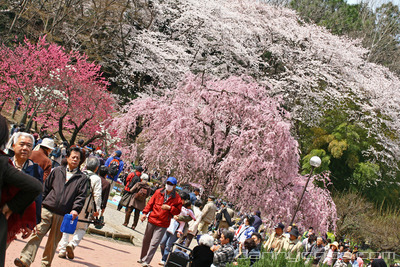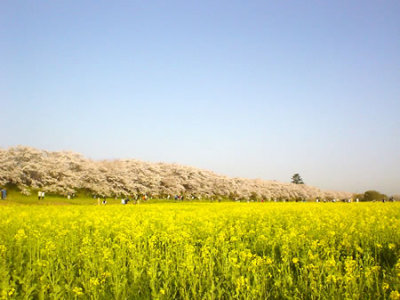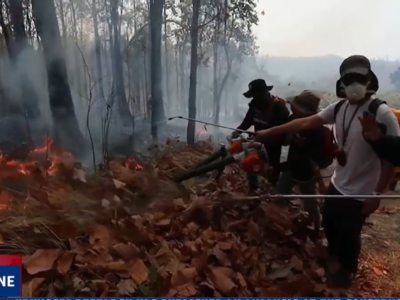What were bloggers writing about this year in the Japanese blogosphere? The year in Japanese blogs at Global Voices included posts on everything from an American Enka singer making waves in Japan, to debates on the regulation of “harmful” Internet content, to the Olympic torch relay in Nagano.
Culture
The year started with new year celebrations, which include eating osechi, a traditional Japanese New Year food, and the Japanese custom of visiting shrines, called Hatsumode.
One blogger wrote of how new years celebrations had changed over the years (translation by Hanako Tokita):
昔の頃のように、古式ゆかしき伝統にのっとったお正月を過ごされたのは
はて どれくらいあるだろう・・・
私が幼い頃は、毎年のお正月にはお約束のようにして
親戚や知人がお年始の挨拶に来られて
それはそれは普段になく 賑やかな感じで まさにお正月!!っという特別な日だった。
御節料理だって、正月にしかお目にかかれない代物ばかり。
When I was a child, every year around New Year, relatives and acquaintances would always come to visit for New Year's greetings.
It was unusually busy and was a special day with a true New Year's feeling.
Osechi was also full of stuff that you would see only at New Year.
されど 時は平成、、、それも20年ともなると
御節料理も普段・・・しかも年中 お目にかかる代物ばかりの食材だし
飽食の時代の申し子とも云える現在っ子達には
めずらしくもなんともないようでして、感激の欠片も無いのが現状のようだ。。。
even osechi is made up entirely of ingredients that one sees everywhere, all year round.
Today's kids, who might be called the children of the age of gluttony, don't seem to find [osechi] unusual and are not thrilled at all. This seems to be the reality…
Staying with the theme of culture, one of Japan's most well-known cultural icons, geisha, have recently taken up blogging. One blogger described how blogging had helped them become a geiko (translation by Scilla Alecci):
なんとかならないか、と色々探していたところ・・・とあるブログを発見
それが、今私を引いて下さったお姉さんのブログだったのです
高級クラブ街だと思っていた北の新地に芸妓さんがいるのかーっ、と目から鱗。
そして、素敵なお着物姿のお写真に・・・一目ぼれ
早速連絡させて頂いて、お会いして頂いて(あまりにお姉さんがお綺麗なので、「私のような小娘がココにいていいのかーっ」恐縮 笑)、見習いさんさせて頂いて(素敵なお茶屋さんに感動 )、芸妓:さく良となったのです。
I tried to contact several geisha houses and organizations in Kyoto but the only replies I got were “Impossible!” or “Only if you start as a maiko”.
Then I gave up and started a normal job, but… no, I couldn't give up. And just when I was considering other ways to make it… I found a certain blog.
It was the blog of an older geisha who eventually drew me in.
I couldn't believe to my eyes when I realized that there were geiko in the north of Shinchi, an area full of classy clubs. And when I saw their pictures in those splendid kimono… it was love at first sight!!
So I asked them to contact and meet me (I couldn't help feeling embarrassed, with such beautiful women, wondering to myself, “Will they accept a young girl like me here?”).
They took me in with them as an apprentice in that wonderful teahouse, and that is how I became Sakura, the geiko.
Media
Under the heading of media, one of the most talked-about topics in Japanese blogs this year was the controversy over WaiWai, a weekly column published in the Japanese newspaper Mainichi shimbun, written by Australian Ryan McConnell. WaiWai featured some of the most scandalous articles from Japan's weekly tabloids, translated to English with added “embellishments”.
GV posts on the WaiWai controversy include a translation of an article by a Japanese resident in Ecuador at a blog entitled Nanmei (南瞑), and an article by blogger Michi Kaifu (海部美知), who contends that to women, WaiWai was sexual harassment. Blogger polimediauk, meanwhile, reacted to Mainichi's apology about the WaiWai articles, complaining about the fact that foreign and Japanese staff have been treated differently in the affair. Mainichi was later embroiled in a separate scandal revolving on a slip-up in which the newspaper erroneously identified a Wikipedia editor as involved in an attempted murder.
Citizen media was another topic discussed in blogs. 2008 saw the demise of the Japanese version of the citizen journalism website OhMyNews, as well as a debate on the collapse of journalism, as expressed in a book by Japanese journalist Takashi Uesugi. Bloggers have also recently written about the crisis in primary news reporting, and about the future of video.
Technology
The year has seen a difficult situation in the IT industry in Japan. A New York Times article explaining how the country is running out of engineers was received positively by bloggers, who expressed concern about the future of IT jobs in Japan.
Another popular topic this year in the area of technology was the arrival of Google's new Street View service, introduced in Japan in August, which brought with it a range of reactions, some supportive but others highly critical. IT professional Osamu Higuchi (樋口理) at Higuchi.com wrote a post in his blog on August 7th titled “Letter to the people at Google”, in which he asks the company: “Could you please remove the residential roads of Japan's urban areas from Street View?” In one passage, he explained how the situation of residential streets in Japan differs from the situation in the West:
米国、特に西海岸に住んでいる人は自宅のプライベート空間とパブリックな空間の境目は、所有権的にも精神的にも公道と私有地の間にあると思います。というか、みなさんの感覚では公道に面した自分の庭のほうが公的な空間で、自分の庭をきれいにしていないとコミュニティの景観上よろしくないと思っていますよね?
ところが日本の都市部生活者は逆で、家の前の生活道路、いわゆる路地のほうが感覚的には自分の生活空間の一部、庭先なのです。日本の都市部では、家の前の公道を掃いたり、打ち水をしたり、雪かきをしたりするのが居住者のつとめとされています。下町を歩いているとよくわかるけれど、家の前の路地に鉢植えとかちょっとした物置とかをはみ出して置いてあるのもその感覚の表れです。
(For follow-up posts on the Street View debate, see GV's special coverage page.)
Society
On the topic of society, the Akihabara knife massacre on June 8th in Tokyo brought with it reflection on the changing nature of labour conditions in Japan and of the difficult situation faced by young people. While some wrote about the deeper social reality which led to the actions of killer Tomohiro Kato, others debated the changing nature of social media, and still others connected the killings to Toyota's Kanban (Just-in-Time) system.
Other social issues discussed in blogs include a series of scandals related to the use of cannabis, the revision of the nationality law, Japanese immigration to Brazil, and the future of the Japanese language.
In closing
On a brighter note, the coming of spring brought with it the fall of cherry blossoms, a few photos of which are included below.

Photo by Danny Choo CC-BY-NC-SA

Photo by sputnik CC-BY-NC-SA







1 comment